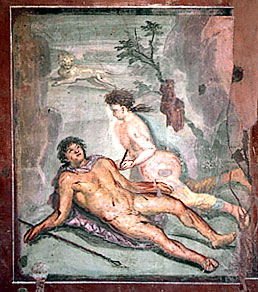Metamorphoses 4.55-166

This wall painting from the garden of a Roman house in Pompeii illustrates the tragic conclusion of one of Ovid's most beloved stories. Here are some questions to start you thinking about the passage:
- What are the main characteristics of Pyramus and Thisbe stressed by Ovid in ll. 55-64, and how does this contrast with Apollo and Daphne? Describe the rhetorical effects in line 64; does the point Ovid is making seem realistic?
- Why does Ovid give such a prominent role to the wall in lines 65-80 (see this painting by the nineteenth-century British artist John William Waterhouse)? Why does Ovid switch to the second-person in line 68; is this effective? What do the words tutae and murmure minimo tell us about the home situation of the young people?
- What poetic effects does Ovid use in lines 71-72 to portray the intensity of their passion? Why do the lovers speak directly to the wall and what do they say? Discuss the effects of nequiquam and oscula non pervenientia in lines 78-80. Does this remind you of anything in Apollo and Daphne? If so, is the effect on the reader the same or different?
- Why does Ovid use the verb coiere in line 83 (compare line 60)? Line 83-89 comprise a single sentence (some editors would include line 90 as well). What is the effect of this passage, with its elaborate syntax and multiple clauses, including two participles and a passive periphrastic? Is there any significance in the place the lovers propose to meet (note especially the words busta, umbra, ardua, gelido)? How do lines 91-92 contrast with what has gone before?
- What does Thisbe do, and what two adjectives describe the new qualities she has acquired through love? What happens to these qualities when she sees the lioness? Note the vivid description conveyed by spumantes oblita rictus (for the effect that Ovid is describing, see this cheetah). Why is this detail important for the plot?
- Why is serius placed at the beginning of line 105, and Pyramus delayed until line 107? What effect is created by juxtaposing una duos in line 109 and ego te in line 110? Why does Pyramus reproach himself and what does he then do (note especially the role played by Thisbe's cloak and the tree)?
- How does Ovid describe Thisbe's mood when she returns? What puzzles her? Note the sharp contrast between her expectations and what she actually finds, marked by the particularly gruesome description in lines 133-36. Why is laniata in line 139 especially appropriate here? Although Thisbe repeatedly calls his name, what word actually causes Pyramus to open his eyes one last time? What is the effect of Thisbe's double repetition of manus and amor in lines 148-50?
- What are Thisbe's final two requests? How does she kill herself? This was a favorite scene for artists; see this woodcut illustrating an edition of Ovid and this sixteenth-century stained glass roundel.